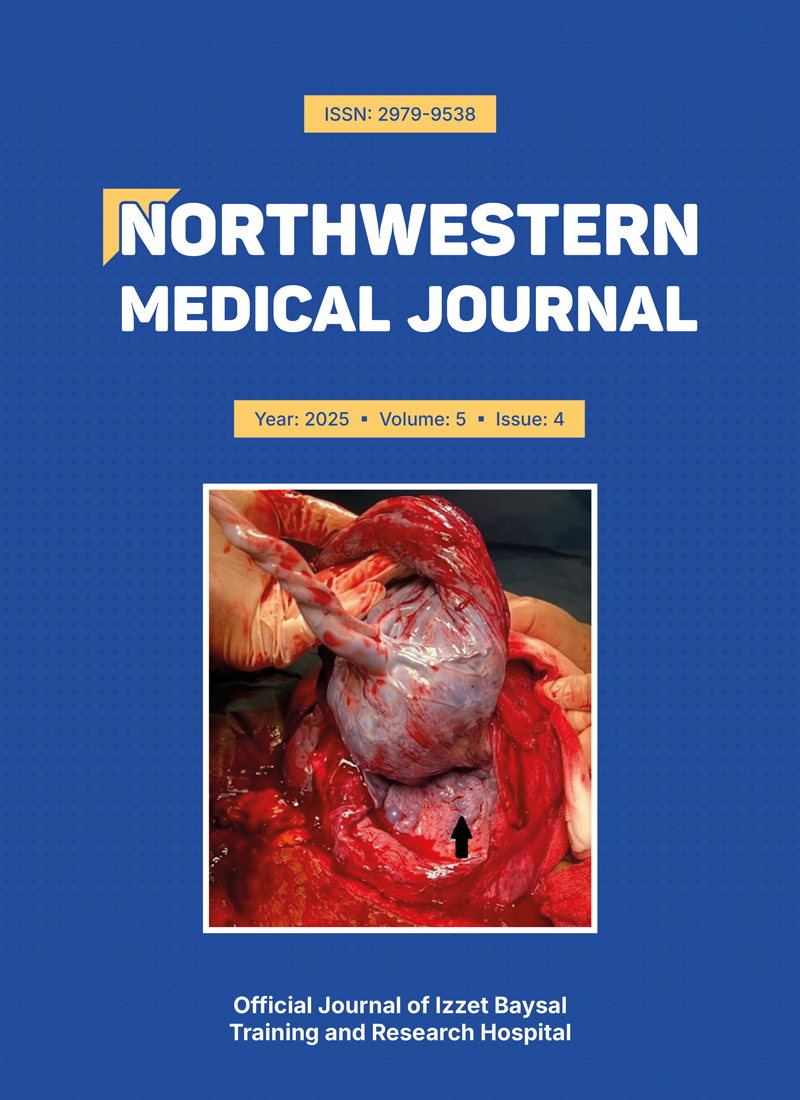Abstract
Aim: This study focused on investigating age- and gender-related changes in the brain ventricles of healthy pediatric individuals.
Methods: Brain MR images of 200 healthy children aged 0-18 years were included in the study. The variables measured were as follows: axis of the third ventricle (ATV), anterior width of the frontal horn (ACF), posterior width of the frontal horn (PCF), width of the frontal horn (WCF), oblique diameter of the frontal horn (OCF), maximum transverse diameter of the skull (MTDS), vertical diameter of the skull (VDS), anteroposterior width of the right temporal horn (ARCT), anteroposterior width of the left temporal horn (ALCT), anteroposterior width of the fourth ventricle (AFV), transverse width of the fourth ventricle (TFV). In addition, the Evans index (EI) has been calculated.
Results: Statistically significant results were found between the individuals of the first, second and fourth groups for the ACF and PCF variables; the fourth group for the WCF, VDS, and TFV variables; the first and fourth groups for ARCT; the first group for ALCT; and the third and fourth groups for MTDS. In the pediatric period, while there was no significant difference between the genders until a certain age, it was observed that the difference between the genders increased especially after a certain age (between 7-18 years).
Conclusion: It is thought that the study will provide basic data for clinical sciences in the stages of diagnosis and treatment planning.
Keywords: Pediatric period, brain ventricles, MRI brain, brain, central nervous system
Copyright and license
Copyright © 2025 The Author(s). This is an open-access article published by Bolu İzzet Baysal Training and Research Hospital under the terms of the Creative Commons Attribution License (CC BY) which permits unrestricted use, distribution, and reproduction in any medium or format, provided the original work is properly cited.
How to cite
References
- Kerscher SR, Schweizer LL, Nägele T, Weichselbaum A, Haas-Lude K, Schuhmann MU. Changes of third ventricle diameter (TVD) mirror changes of the entire ventricular system after initial therapy and during follow-up in pediatric hydrocephalus. Eur J Paediatr Neurol. 2019; 23(4): 571-80. https://doi.org/10.1016/j.ejpn.2019.05.008
- Khan AF, Drozd JJ, Moreland RK, et al. A novel MRI-compatible brain ventricle phantom for validation of segmentation and volumetry methods. J Magn Reson Imaging. 2012; 36(2): 476-82. https://doi.org/10.1002/jmri.23612
- Fame RM, Cortés-Campos C, Sive HL. Brain Ventricular System and Cerebrospinal Fluid Development and Function: Light at the End of the Tube: A Primer with Latest Insights. Bioessays. 2020; 42(3): e1900186. https://doi.org/10.1002/bies.201900186
- Stratchko L, Filatova I, Agarwal A, Kanekar S. The Ventricular System of the Brain: Anatomy and Normal Variations. Semin Ultrasound CT MR. 2016; 37(2): 72-83. https://doi.org/10.1053/j.sult.2016.01.004
- Karaca O, Buyukmert A, Tepe N, Ozcan E, Kus I. Volume estimation of brain ventricles using Cavalieri’s principle and Atlas-based methods in Alzheimer disease: Consistency between methods. J Clin Neurosci. 2020; 78: 333-8. https://doi.org/10.1016/j.jocn.2020.04.092
- Korzh V. Development of brain ventricular system. Cell Mol Life Sci. 2018; 75(3): 375-83. https://doi.org/10.1007/s00018-017-2605-y
- Kremen WS, Panizzon MS, Neale MC, et al. Heritability of brain ventricle volume: converging evidence from inconsistent results. Neurobiol Aging. 2012; 33(1): 1-8. https://doi.org/10.1016/j.neurobiolaging.2010.02.007
- Ma W, Li XJ, Li W, Xiao L, Ji XJ, Xu Y. MRI findings of central nervous system involvement in children with haemophagocytic lymphohistiocytosis: correlation with clinical biochemical tests. Clin Radiol. 2021; 76(2): 159.e9-159.e17. https://doi.org/10.1016/j.crad.2020.09.009
- Shao M, Han S, Carass A, et al. Brain ventricle parcellation using a deep neural network: Application to patients with ventriculomegaly. Neuroimage Clin. 2019; 23: 101871. https://doi.org/10.1016/j.nicl.2019.101871
- Zhuravlova I, Kornieieva M, Rodrigues E. Anatomic Variability of the Morphometric Parameters of the Fourth Ventricle of the Brain. J Neurol Surg B Skull Base. 2018; 79(2): 200-4. https://doi.org/10.1055/s-0037-1606331
- Idowu OE, Balogun MM. Visual function in infants with congenital hydrocephalus with and without myelomeningocoele. Childs Nerv Syst. 2014; 30(2): 327-30. https://doi.org/10.1007/s00381-013-2222-5
- Arun Kumar S, Meena Kumari S, Vijai Anand M, Saraswathy R, Rajeshwari M. Evaluation of Evan’s Index in South Indian Population using Computed Tomography. International Journal of Anatomy, Radiology and Surgery. 2017; 6(3): RO28-RO31. https://doi.org/10.7860/ijars/2017/29922
- Utsunomiya H, Takano K, Okazaki M, Mitsudome A. Development of the temporal lobe in infants and children: analysis by MR-based volumetry. AJNR Am J Neuroradiol. 1999; 20(4): 717-23.
- Idowu O, Olumide A. Etiology and cranial CT scan profile of nontumoral hydrocephalus in a tertiary black African hospital. J Neurosurg Pediatr. 2011; 7(4): 397-400. https://doi.org/10.3171/2011.1.PEDS10481
- Turner B, Ramli N, Blumhardt LD, Jaspan T. Ventricular enlargement in multiple sclerosis: a comparison of three-dimensional and linear MRI estimates. Neuroradiology. 2001; 43(8): 608-14. https://doi.org/10.1007/s002340000457
- Polat S, Öksüzler FY, Öksüzler M, Kabakci AG, Yücel AH. Morphometric MRI study of the brain ventricles in healthy Turkish subjects. International Journal of Morphology. 2019; 37(2): 554-60. https://doi.org/10.4067/S0717-95022019000200554
- Aukland SM, Odberg MD, Gunny R, Chong WKK, Eide GE, Rosendahl K. Assessing ventricular size: is subjective evaluation accurate enough? New MRI-based normative standards for 19-year-olds. Neuroradiology. 2008; 50(12): 1005-11. https://doi.org/10.1007/s00234-008-0432-4
- Hamidu AU, Olarinoye-Akorede SA, Ekott DS, Danborno B, Mahmud MR, Balogun MS. Computerized tomographic study of normal Evans index in adult Nigerians. J Neurosci Rural Pract. 2015; 6(1): 55-8. https://doi.org/10.4103/0976-3147.143195











